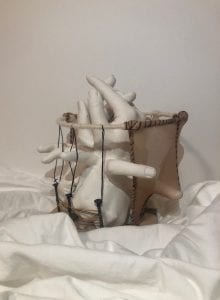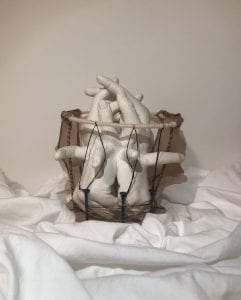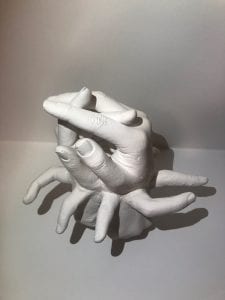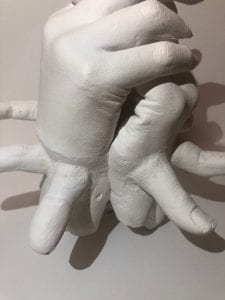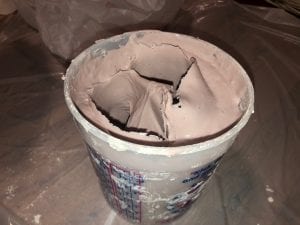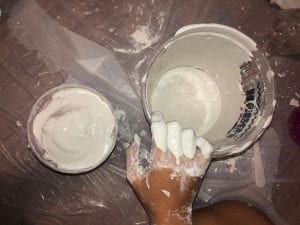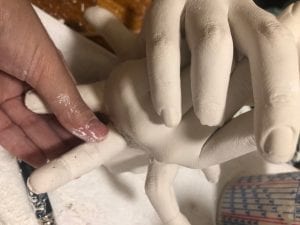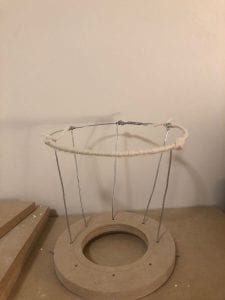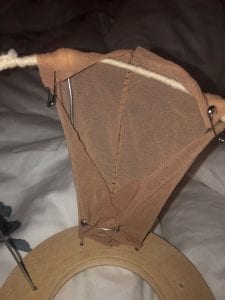- Part 1:Describe your process of making an alginate body mold and a plaster cast, and explain when and how in that process you altered the cast. Describe the nature/feelings/character of the memory you cultivated through the orientation, gesture, and alteration of the cast.
The first two times of making the alginate mold, I failed miserably. I had to buy 3 bags of alginate to get it perfect for the last time. I used warm water and mixed for too long and the reaction of the alginate and warm water activated the process and started to harden before I could mold my hands. Once I had my alginate body mold, I had to start mixing my plaster. Mixing the plaster with hands was easier to get the clumped chunks to spread and mix. Once the mix was ready I poured it into the mold. I used a small spoon to pour plaster into my fingers so that it would fill the space and then i poured the mix from the mixing bowl into the palm/hand area. Then I hit the sides and the floor to get the air bubbles out. After the plaster was hardened, I ripped the mold off slowly by cutting away at the parts I knew my mold was not in. Then with my finger I started to chip the alginate away. For the alginate stuck in wrinkled areas of the cast, I used a thin tweezer to pluck it out. I found the process to be very interactive to use your body to mix and also to mold/cast. I made two plaster casts and both the process is the same.
For my first mold, I had my hands together but broke off my fingers so it would be able to support and stand from where it had been broken. Then for my second mold aI had my hands closed together.
I then attached the two casts from where the wrists would be at. I attached it by putting plaster on the middle and the sides. Then I added my broken off fingers from my first cast to circle around where it had been attached. The top of the cast has two hands formed together and I wanted it to be prayer hands. But its not completely closed, I wanted it to show a broken prayer of plee.
I wanted to invoke a calming feeling yet an uneasy and creepy feeling. The top of my cast is the hands crossed together to show rest and the bottom and the side fingers to show unsteadiness. Almost a cry for help but no one is helping. I wanted the bottom to feel dense and heavy because I wanted to show a feeling of your heart sinking or when you feel like your “heart dropped”.
- Part 2: What kind(s) of inhabitable space(s) in the real world inform the inhabitable space you made?Carefully and specifically describe the qualities, character, psychological state, sensations, and atmosphere you would like your inhabitable space to evoke from your memory.
I was inspired to make my inhabitable space from a big field of yellowing grass and yellow flowers spread out with a single tree 20 meters away from a white barnhouse style home with a big porch. I wanted my inhabitable space to feel homey yet eerie. Like it was a suffocating area but still weirdly welcoming. I wanted it to be ironic, showing one thing but also meaning another.
I created a cylinder shaped “prison” for my cast, that has cut up and and sewed on pantyhoes on the side. I used neutral tones because of my memories color palette.
White flowy bed sheet is also sewed on from the bottom of the inhabitable space.
- Part 1 and Part 2: Discuss the design elements of mass, texture, and volume and their relationship to each other in your project.
I wanted my cast of hands to go inside and inhabit the cylinder shaped form. The fingers that are attached in the middle to protrude out of the pantyhoes to show and present as if it was trying to escape and trying to go through but being stuck in the place it doesn’t want to be in. The gestures of the fingers are twisted displaying from the pantyhoes. The mass of the inhabitable space is hollow and the volume of the inhabitable space is also very light. However the cast is dense and heavy that is weighed inside the the inhabitable space that creates a dense feeling as a whole. Their relationship is about the cast being the main but the inhabitable space supporting the cast and being a support system to the cast overall.
- How does the design principle of repetition play a role in the organization of space or material in your work?
For my cast I have two hands attached from the wrist and around where it had been attached, it has eight fingers protruding out around it. For my inhabitable space, It is made from two circular surroundings, bottom wood and top wire. The wire has wool yarn circling around it. It has has wire from top to bottom attached again circling it. Also the repetition can be found from the sewing process that was used to attached the pantyhoes to the side of my inhabitable space.
- A. Name the found object(s) used in the construction of your inhabitable space, and explain what meanings or content the found object brings to your piece from its intended use/function/associations as an ordinary mass-produced object.
The found objects are the pantyhoes that was used for the sides of the inhabitable space. The reason why I used this object was because of its stretchy character. Pantyhoes is used to cover and latch on to legs. It is stretchy and if you put your legs through it, it molds around your leg. The construction of my inhabitable spaces makes it as a barrier so that the fingers protrude but stays inside the pantyhoes. I wanted it show entrapment but as if it was a tease. The fingers can be shown from the pantyhose on the outside as if it is close to escaping but being trapped, I found that to be frustrating.
Another is the screws. The meaning of the object is to screw on or hold together objects but I used it for the intention of the height, the height is not long enough to be from the top to bottom but to be from the middle to the bottom.
I also used white bed sheets that is connected to the bottom of the inhabitable space. It is to create warmth and a place to lay.
- Explain how you directed or added new meaning/content to the found object(s) in your piece through modification, making processes, and/or physically unifying it into your piece as a whole.
I think it created a new definition. It was made for protection or to cover so that skin would not be open. However the modification shows that it is not to cover or to be conservative, it is to show as a entrapment. It shows frustration and tension that was there to scare the casted hand.
For the screws, the reason why I chose the length and the number of screws is because I wanted to show that it can almost escape but it can’t. I wanted to show hope but the hope is not possible to be let out. The bed sheets attached is to be almost like a field, to show the outside world is shown as a peaceful place. It was to emphasize the the cast and the main part of the inhabitable space to show fear.
- Explain how you tailored your inhabitable space to your cast, or how you customized a space specifically for your cast to inhabit (discuss ergonomics, contact points between structure and cast, the relationship between surfaces, the size of the space, and the proportion of negative space to your altered cast).
I wanted it to be shorter than my cast and the fitting to be tight so that there would be a little negative space. The reason for that was to show suffocation and a tight space that my cast would be in. The fingers are placed so that it would stretch out the pantyhoes and go through the space of the open sides. Also shows the fingers are on top of the nail beds. The top of the cast goes through the top of the inhabitable space because it’s a cry for help to ”God”. It is in a broken prayer hand to show through the top circular area made of wire. The bedsheet is spread under the cast and main part of the inhabitable space although the bedsheet is a part of the inhabitable space.
- Discuss how and where in the classroom you presented your finished project 2, and why you chose to display your piece that way.
I wanted to place it next to the window where the sun could be shining on it for two reasons. The first reason was because the hands of the broken prayer was a cry for help to God. I wanted to show that God was only looking and not being of help. The second reason being that it was for the memory. It was bright and yellow and beautiful. I wanted to be able to portray comfort and peace on the white sheets.
- Discuss other important aspects of your project not mentioned above, such as how you delineated interior/exterior space, how you designed a threshold, how energy flows into, through, and out of your piece, how senses besides sight are involved in experiencing your project, how you used light or color, or anything else you wish to discuss.
The energy I believe is held inside the prison with the hand cast. The reason I say that is because it is wanting to escape but cannot because it is trapped. It is about the almost that keeps it a tease. The color scheme is what keeps you calm but if you look closely it is each detail that tells you another story. From the stitching, it shows the tightness and how it is closed together. The shape of the inhabitable space(prison) is mostly circular, it doesn’t have hard edges, it is soft yet bounding.
My project was about colliding two worlds together as if it didn’t make sense. It was to invoke irony and anxious sadness to it.
- Write about three specific ways your work for this project relates to the work of artists we studied for this project, which include artists from the videos, the reading, and class lecture. Make sure you include each artist’s name (ask if you cannot remember).
Louise Bourgeois is one the artist that stood out to me most because in her video she said her favorite is the original plaster because she can see all the wrinkles. The reason I say this is because I was so fascinated my cast was able to portray all the wrinkles and details of my hand.
Doris Salcedo work is about other people’s experience, she tries to rescue memories. Something that is no longer here but her work shoes it subtly. The main idea of project 2 was to use your own memories. It was to bring your memory alive but not visually showing it.
Do Ho Suh made transportable fabrics. He wanted to carry his home like a snail and was able to fold and carry his art. I used bed sheet for my inhabitable space that i can fold into a smaller mold but can unfold it to be a larger space.
- To you, what is the most important or exciting aspect of your project or your process for project 2?
The most important part of this project was learning how to handle wet materials. It was my first time so it was a lot of trials. However, it brought me to understand the relationship it has with art and emotions. I found it hard to portray my memory but it was about seeing what materials worked and what materials didn’t. I also had in interesting relationship to my hand. I didn’t know at first a single detail such as a finger can create a different emotion. It was hard but it was a lot of fun to be honest. I don’t think there is a singular thing I can choose because of the fact each process or part was so different. It was about combining different aspects into one whole unified work. However, what I took most out of it was the details were important. Each detail made a difference from the hand position, to where it wrinkled, what color was appropriate and what shaped could create what I wanted to evoke. Each detail created energy in different ways. It gave out different energies and held it in places I wanted it to be held.
